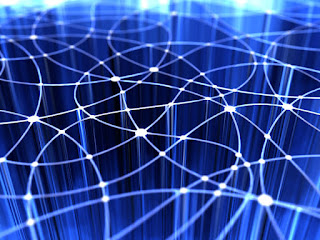New Switching Device Could Help Build an Ultrafast 'Quantum Internet'
Northwestern University researchers have developed a new switching device that takes quantum communication to a new level. The device is a practical step toward creating a network that takes advantage of the mysterious and powerful world of quantum mechanics.
The researchers can route quantum bits, or entangled particles of light, at very high speeds along a shared network of fiber-optic cable without losing the entanglement information embedded in the quantum bits. The switch could be used toward achieving two goals of the information technology world: a quantum Internet, where encrypted information would be completely secure, and networking superfast quantum computers.
The device would enable a common transport mechanism, such as the ubiquitous fiber-optic infrastructure, to be shared among many users of quantum information. Such a system could route a quantum bit, such as a photon, to its final destination just like an e-mail is routed across the Internet today.
The research -- a demonstration of the first all-optical switch suitable for single-photon quantum communications -- is published by the journal Physical Review Letters.
"My goal is to make quantum communication devices very practical," said Prem Kumar, AT&T Professor of Information Technology in the McCormick School of Engineering and Applied Science and senior author of the paper. "We work in fiber optics so that as quantum communication matures it can easily be integrated into the existing telecommunication infrastructure."
The bits we all know through standard, or classical, communications only exist in one of two states, either "1" or "0." All classical information is encoded using these ones and zeros. What makes a quantum bit, or qubit, so attractive is it can be both one and zero simultaneously as well as being one or zero. Additionally, two or more qubits at different locations can be entangled -- a mysterious connection that is not possible with ordinary bits.
Researchers need to build an infrastructure that can transport this "superposition and entanglement" (being one and zero simultaneously) for quantum communications and computing to succeed.
The qubit Kumar works with is the photon, a particle of light. A photonic quantum network will require switches that don't disturb the physical characteristics (superposition and entanglement properties) of the photons being transmitted, Kumar says. He and his team built an all-optical, fiber-based switch that does just that while operating at very high speeds.
To demonstrate their switch, the researchers first produced pairs of entangled photons using another device developed by Kumar, called an Entangled Photon Source. "Entangled" means that some physical characteristic (such as polarization as used in 3-D TV) of each pair of photons emitted by this device are inextricably linked. If one photon assumes one state, its mate assumes a corresponding state; this holds even if the two photons are hundreds of kilometers apart.
The researchers used pairs of polarization-entangled photons emitted into standard telecom-grade fiber. One photon of the pair was transmitted through the all-optical switch. Using single-photon detectors, the researchers found that the quantum state of the pair of photons was not disturbed; the encoded entanglement information was intact.
"Quantum communication can achieve things that are not possible with classical communication," said Kumar, director of Northwestern's Center for Photonic Communication and Computing. "This switch opens new doors for many applications, including distributed quantum processing where nodes of small-scale quantum processors are connected via quantum communication links."





















“this is very interesting. thanks for that. we need more sites like this. i commend you on your great content and excellent topic choices.”
ReplyDelete